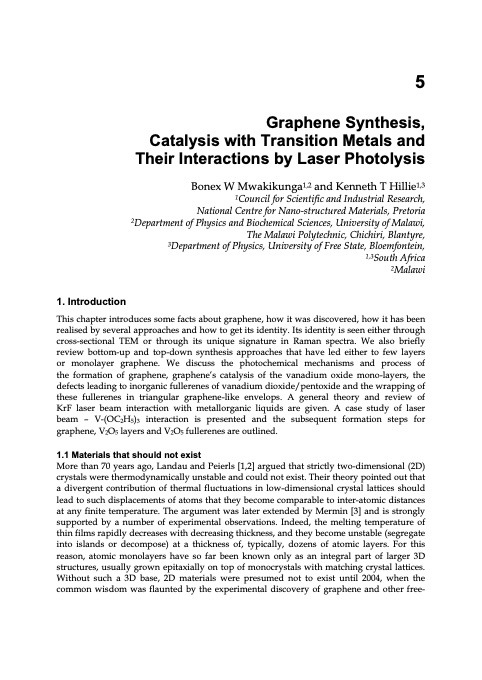PDF Publication Title:
Text from PDF Page: 069
1. Introduction 5 Graphene Synthesis, Catalysis with Transition Metals and Their Interactions by Laser Photolysis Bonex W Mwakikunga1,2 and Kenneth T Hillie1,3 1Council for Scientific and Industrial Research, National Centre for Nano-structured Materials, Pretoria 2Department of Physics and Biochemical Sciences, University of Malawi, The Malawi Polytechnic, Chichiri, Blantyre, 3Department of Physics, University of Free State, Bloemfontein, 1,3South Africa 2Malawi This chapter introduces some facts about graphene, how it was discovered, how it has been realised by several approaches and how to get its identity. Its identity is seen either through cross-sectional TEM or through its unique signature in Raman spectra. We also briefly review bottom-up and top-down synthesis approaches that have led either to few layers or monolayer graphene. We discuss the photochemical mechanisms and process of the formation of graphene, graphene’s catalysis of the vanadium oxide mono-layers, the defects leading to inorganic fullerenes of vanadium dioxide/pentoxide and the wrapping of these fullerenes in triangular graphene-like envelops. A general theory and review of KrF laser beam interaction with metallorganic liquids are given. A case study of laser beam – V-(OC2H5)3 interaction is presented and the subsequent formation steps for graphene, V2O5 layers and V2O5 fullerenes are outlined. 1.1 Materials that should not exist More than 70 years ago, Landau and Peierls [1,2] argued that strictly two-dimensional (2D) crystals were thermodynamically unstable and could not exist. Their theory pointed out that a divergent contribution of thermal fluctuations in low-dimensional crystal lattices should lead to such displacements of atoms that they become comparable to inter-atomic distances at any finite temperature. The argument was later extended by Mermin [3] and is strongly supported by a number of experimental observations. Indeed, the melting temperature of thin films rapidly decreases with decreasing thickness, and they become unstable (segregate into islands or decompose) at a thickness of, typically, dozens of atomic layers. For this reason, atomic monolayers have so far been known only as an integral part of larger 3D structures, usually grown epitaxially on top of monocrystals with matching crystal lattices. Without such a 3D base, 2D materials were presumed not to exist until 2004, when the common wisdom was flaunted by the experimental discovery of graphene and other free-PDF Image | GRAPHENE SYNTHESIS CHARACTERIZATION PROPERTIES

PDF Search Title:
GRAPHENE SYNTHESIS CHARACTERIZATION PROPERTIESOriginal File Name Searched:
Graphene-Synthesis.pdfDIY PDF Search: Google It | Yahoo | Bing
Salgenx Redox Flow Battery Technology: Power up your energy storage game with Salgenx Salt Water Battery. With its advanced technology, the flow battery provides reliable, scalable, and sustainable energy storage for utility-scale projects. Upgrade to a Salgenx flow battery today and take control of your energy future.
CONTACT TEL: 608-238-6001 Email: greg@infinityturbine.com (Standard Web Page)